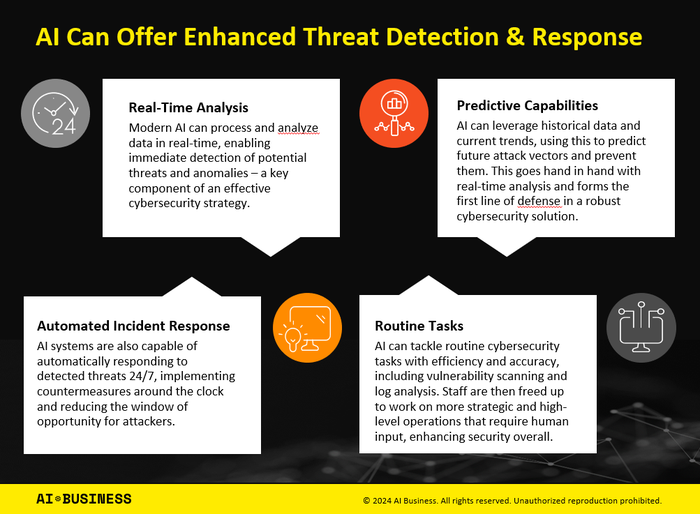AI in Cybersecurity: Understanding the Digital Security Landscape
Learn about how AI has become a game-changer in the cybersecurity space, enabling enhanced threat detection and proactive security.

Introduction to AI in Cybersecurity
Today’s cybersecurity risks are much broader than they have been historically. Our current era is dominated by digital transactions and communications, and more sophisticated cybersecurity challenges have emerged. Threats today include ransomware attacks, phishing scams, supply chain attacks, AI-powered attacks, IoT device vulnerabilities, cloud security threats, and state-sponsored cyber warfare.
In this increasingly complex landscape, AI can enhance cybersecurity by automating complex processes for detecting and responding to threats. Machine learning can also be leveraged to learn from historical incidents and improve responses over time.
Since the late 1980s, AI has been used for basic anomaly detection. More recently, however, the integration of AI in cybersecurity solutions has increased. As the complexity of threats has grown, the use of AI in cybersecurity has expanded to predictive analytics, automated incident response, behavioral analytics, network security and more. Deep learning techniques have also allowed for better detection of complex – and subtle – cybersecurity threats, including zero-day exploits.
AI’s evolution in cybersecurity is reflective of a broader trend of leveraging technology to address rapidly developing threats. Contemporary AI is being used to gather and analyze threat intelligence from various sources. It can then provide insights into emerging threats to help organizations prepare and respond more effectively.
As AI improves, efforts will also need to be made to understand and defend against adversarial AI – where attackers use AI to evade detection, or even create more sophisticated attacks.
The Growing Intersection of AI and Cybersecurity
Digital transformation across many industries has greatly expanded the attack surface for cyber threats, resulting in AI counters being a necessity, rather than optional. AI algorithms have become the crucial building blocks of secure cloud environments, IoT devices, and mobile platforms. For AI in cybersecurity, there is a dual narrative: With technological advancement there are not only new fronts for cyber threats but also innovative AI solutions to combat them.
Increased Digital Footprint
In the last decade, there has been an exponential increase in digital operations across organizations and businesses in all sectors. The expansion of cloud computing, IoT, and more, has resulted in greatly expanded digital infrastructure, resulting in broader attack vectors for cyber threats. Furthermore, the complexity of these systems has increased, introducing new vulnerabilities, and hampering the efforts of traditional security measures.
Enhanced Threat Detection and Response
The sheer volume and complexity of data in modern digital activities necessitates the advanced analytical capabilities of AI for monitoring, threat detection, and response.
Real-time Analysis
The key selling point of modern AI systems is their ability to process and analyze real-time data, enabling immediate detection of potential threats and anomalies. This is a crucial component of an effective cybersecurity strategy, preventing attacks before they can cause any significant damage.
Predictive Capabilities
AI cybersecurity solutions can leverage historical data and current trends, allowing them to predict future attack vectors and prevent them. Predictive capabilities go hand in hand with real-time analysis and form the first line of defense in a robust cybersecurity solution.
Automated Incident Response
AI systems are also capable of automatically responding to detected threats 24/7, implementing countermeasures around the clock and reducing the window of opportunity for attackers.
Routine Tasks
AI can help with routine, and repetitive, cybersecurity tasks with efficiency and accuracy, including vulnerability scanning and log analysis. This can free up staff to work on more strategic and high-level operations that require human input, enhancing security overall.

How AI can provide Enhanced Threat Detection & Response
Challenges and Limitations
Despite the great benefits AI solutions in cybersecurity offer, there are several challenges and limitations that make AI less of a boon for cybersecurity.
Data Quality and Privacy
AI can suffer from various data quality issues, such as false positives and negatives. One of the challenges in using AI for cybersecurity is managing these issues, which can often lead to unnecessary alerts or completely overlooking actual threats. These sorts of issues could crop up, for example, where an AI solution is running most of the day-to-day vulnerability scanning without human intervention.
Implementing AI models in cybersecurity also increases the risk of a data privacy breach. AI will be required to handle sensitive data in these scenarios, so robust data protection measures must be implemented to account for these concerns.
Adversarial AI
There is, of course, always the possibility that AI can be used by attackers, both by using AI techniques themselves, as well as bypassing AI security using known vulnerabilities. This necessitates constant research and development within organizations to ensure that they stay ahead of the attackers.
Why is AI a Game-Changer for Cybersecurity?
AI is considered a game-changer for cybersecurity. Cybersecurity faces an arms race against constantly changing, and increasingly sophisticated, cyber threats. Traditional defense mechanisms are still essential, but they often fall short against the creativity and adaptability of modern criminals in the digital landscape. AI can be transformative in this space, offering a paradigm shift with capabilities that can fundamentally change how threats are detected, analyzed and neutralized.
Adapting to Evolving Threats
AI is capable of dynamic learning, which allows it to quickly adapt to evolving threats – a crucial element of a modern cybersecurity solution. Traditional systems rely on predefined rules and signatures, while AI systems can analyze patterns and detect anomalies – all in real time. This adaptability is an essential component in defending against zero-day vulnerabilities and sophisticated cyber-attacks. Often, conventional methods of security miss these vulnerabilities.
Scale and Efficiency
Modern AI offers the ability to scale and efficiently process and analyze vast amounts of data. A common task in cybersecurity operations is sifting through terabytes of data to identify potential threats. This is largely impractical for humans, but an AI can automate this analysis and identify threats more quickly and accurately. This also largely reduces response times, limiting damage from cyber-attacks. As previously mentioned, this has a knock-on effect, allowing human operators to focus more on strategy, freeing up valuable time and improving productivity.
Cybersecurity Trends Shaped By AI
AI’s continued impact on cybersecurity is undeniable, and as AI evolves, it will continue to be transformative in this sector. AI’s adoption in cybersecurity has not only led to improved outcomes, but it has also opened the door to new trends that are shaping the future of digital security. These trends, in general, reflect the increased sophistication of cyber threats and the growing need for advanced and proactive security solutions.
Shift Toward Proactive Defense
As mentioned already, AI enhances the ability to defend against cybersecurity threats proactively rather than reactively. The predictive analytics of AI solutions enable identification of vulnerabilities and threats long before they are exploited. It minimizes the risk of breaches and reduces the impact of attacks. Proactive defense is becoming more and more important in cybersecurity and will continue this trajectory as AI solutions become more sophisticated.
Integration with Emerging Technologies
The integration of AI with other emerging technologies is also an important, blossoming trend. AI is not operating in isolation. Integration with distributed ledger technology, cloud computing, and IoT is important in providing a full-service solution. For IoT, AI can be crucial in managing and securing the vast amounts of data generated by connected devices. It can also be used to identify and mitigate potential threats in these networks. These synergies will help to create more robust and resilient cybersecurity solutions.
Improved Regulatory Compliance
Regulatory compliance in cybersecurity can be a hard mountain to climb. However, while the landscape is becoming ever more complex, AI is making it more manageable. AI-driven solutions can automate the compliance process, ensuring organizations adhere to data protection laws and industry standards, without the weight of the manual effort previously required.
This can include real-time monitoring for compliance and predicting areas of non-compliance before they become an issue. This level of assistance will become invaluable as regulations become stricter and more intricate.
How AI is shaping cybersecurity trends
Industry Impacts: How Different Sectors Leverage AI in Cybersecurity
AI integration has revolutionized the way businesses, organizations, and governments protect their digital infrastructure. Two key areas where AI has played a critical role are the financial sector, and the health care sector.
Financial Sector: AI for Fraud Detection and Prevention
AI plays a critical role in the financial sector, enhancing security measures to combat fraud and financial crimes. Financial institutions have been leveraging AI-driven algorithms to analyze vast amounts of transaction data in real-time. This has enabled them to better detect and identify fraudulent activities. Using machine learning models enables banks and financial institutions to detect anomalies that stray from normal activity, including unusual transaction locations, high-risk transfers and atypical spending behavior.
Integrated AI can also detect and predict potential vulnerabilities, offering up preventative measures and reducing the risk of financial fraud.
Another area where the financial sector is leveraging AI in cybersecurity is customer service/support. AI-powered chatbots and authentication systems improve customer service, security, and responsiveness. Biometric verification and natural language processing help to detect phishing attempts and ensure user identities are secure.
Health Care: Safeguarding Sensitive Data Against Breaches
Health care faces distinct cybersecurity challenges, most importantly in protecting patient data against breaches. Advances in AI have become instrumental in enhancing data protection and compliance within various regulatory standards across the world. AI allows health care providers to monitor and analyze data access patterns, identifying and mitigating the risks of unauthorized access and data exfiltration. Many providers also use AI-driven encryption to secure transmissions of patient data. Furthermore, machine learning algorithms can help in detecting malware and ransomware attacks that target health care systems.
As in other sectors, AI in health care is used for detection and prevention, enabling proactive security measures to defend patient data and health care infrastructure.
AI in Cybersecurity is a Paradigm Shift
The opportunity for AI in cybersecurity represents a significant paradigm shift for the digital space. AI’s integration is multifaceted and will have lots of implications on the efficiency and effectiveness of threat detection and response, and will pave the way for proactive defense mechanisms. However, the continued growth of AI will lead to increased threats in this space. Organizations and businesses will need to stay abreast of the latest developments in this space, as AI sees increasing use by bad actors.
Fortunately, AI’s intersection with several other emerging technologies underscores its potential to bolster digital defenses against these sophisticated cyber threats. AI’s journey in cybersecurity is a testament to the rapid technological changes that have taken place in the last decade and, while AI has been in use for many years in cybersecurity, it is only now that AI promises to become a game-changer in the field. Continuous research and development will cement AI’s role in cybersecurity and unlock its full potential in the coming years.
About the Author(s)
You May Also Like


.jpg?width=700&auto=webp&quality=80&disable=upscale)
.jpg?width=700&auto=webp&quality=80&disable=upscale)
.jpg?width=700&auto=webp&quality=80&disable=upscale)
.jpg?width=300&auto=webp&quality=80&disable=upscale)
.jpg?width=300&auto=webp&quality=80&disable=upscale)
.jpg?width=300&auto=webp&quality=80&disable=upscale)
.jpg?width=300&auto=webp&quality=80&disable=upscale)
.jpg?width=300&auto=webp&quality=80&disable=upscale)